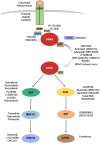Targeting KRAS: The Elephant in the Room of Epithelial Cancers
- PMID: 33777798
- PMCID: PMC7991835
- DOI: 10.3389/fonc.2021.638360
Targeting KRAS: The Elephant in the Room of Epithelial Cancers
Abstract
Mutations of the proto-oncogene KRAS are the most frequent gain-of-function alterations found in cancer. KRAS is mutated in about 30% of all human tumors, but it could reach more than 90% in certain cancer types such as pancreatic adenocarcinoma. Although historically considered to be undruggable, a particular KRAS mutation, the G12C variant, has recently emerged as an actionable alteration especially in non-small cell lung cancer (NSCLC). KRASG12C and pan-KRAS inhibitors are being tested in clinical trials and have recently shown promising activity. Due to the difficulties in direct targeting of KRAS, other approaches are being explored. The inhibition of target upstream activators or downstream effectors of KRAS pathway has shown to be moderately effective given the evidence of emerging mechanisms of resistance. Various synthetic lethal partners of KRAS have recently being identified and the inhibition of some of those might prove to be successful in the future. The study of escape mechanisms to KRAS inhibition could support the utility of combination strategies in overcoming intrinsic and adaptive resistance and enhancing clinical benefit of KRASG12C inhibitors. Considering the role of the microenvironment in influencing tumor initiation and promotion, the immune tumor niche of KRAS mutant tumors has been deeply explored and characterized for its unique immunosuppressive skewing. However, a number of aspects remains to be fully understood, and modulating this tumor niche might revert the immunoresistance of KRAS mutant tumors. Synergistic associations of KRASG12C and immune checkpoint inhibitors are being tested.
Keywords: G12C mutation; KRAS; NSCLC; colon cancer; pancreatic cancer.
Copyright © 2021 Merz, Gaule, Zecchetto, Cavaliere, Casalino, Pesoni, Contarelli, Sabbadini, Bertolini, Mangiameli, Milella, Fedele and Melisi.
Conflict of interest statement
The authors declare that the research was conducted in the absence of any commercial or financial relationships that could be construed as a potential conflict of interest.
Figures
Similar articles
-
Targeting KRASG12C in Non-Small-Cell Lung Cancer: Current Standards and Developments.Drugs. 2024 May;84(5):527-548. doi: 10.1007/s40265-024-02030-7. Epub 2024 Apr 16. Drugs. 2024. PMID: 38625662 Review.
-
Targeting KRASp.G12C Mutation in Advanced Non-Small Cell Lung Cancer: a New Era Has Begun.Curr Treat Options Oncol. 2022 Dec;23(12):1699-1720. doi: 10.1007/s11864-022-01033-4. Epub 2022 Nov 17. Curr Treat Options Oncol. 2022. PMID: 36394791 Review.
-
Assessment of KRASG12C inhibitors for colorectal cancer.Front Oncol. 2024 Jun 24;14:1412435. doi: 10.3389/fonc.2024.1412435. eCollection 2024. Front Oncol. 2024. PMID: 38978742 Free PMC article. Review.
-
KRASG12C inhibition using MRTX1257: a novel radio-sensitizing partner.J Transl Med. 2023 Oct 31;21(1):773. doi: 10.1186/s12967-023-04619-0. J Transl Med. 2023. PMID: 37907934 Free PMC article.
-
Epithelial-to-Mesenchymal Transition is a Cause of Both Intrinsic and Acquired Resistance to KRAS G12C Inhibitor in KRAS G12C-Mutant Non-Small Cell Lung Cancer.Clin Cancer Res. 2020 Nov 15;26(22):5962-5973. doi: 10.1158/1078-0432.CCR-20-2077. Epub 2020 Sep 8. Clin Cancer Res. 2020. PMID: 32900796
Cited by
-
Biological and genetic characterization of a newly established human primary multidrug-resistant distal cholangiocarcinoma cell line, CBC3T-6.Sci Rep. 2024 Nov 29;14(1):29661. doi: 10.1038/s41598-024-81392-0. Sci Rep. 2024. PMID: 39613883 Free PMC article.
-
KRAS Mutation Subtypes and Their Association with Other Driver Mutations in Oncogenic Pathways.Cells. 2024 Jul 19;13(14):1221. doi: 10.3390/cells13141221. Cells. 2024. PMID: 39056802 Free PMC article. Review.
-
Lung Adenocarcinoma Tumor Origin: A Guide for Personalized Medicine.Cancers (Basel). 2022 Mar 30;14(7):1759. doi: 10.3390/cancers14071759. Cancers (Basel). 2022. PMID: 35406531 Free PMC article. Review.
-
Potential biomarkers uncovered by bioinformatics analysis in sotorasib resistant-pancreatic ductal adenocarcinoma.Front Med (Lausanne). 2023 Jun 15;10:1107128. doi: 10.3389/fmed.2023.1107128. eCollection 2023. Front Med (Lausanne). 2023. PMID: 37396909 Free PMC article.
-
In vivo targeted and deterministic single-cell malignant transformation.Elife. 2025 Mar 25;13:RP97650. doi: 10.7554/eLife.97650. Elife. 2025. PMID: 40130618 Free PMC article.
References
Publication types
LinkOut - more resources
Full Text Sources
Other Literature Sources
Miscellaneous


